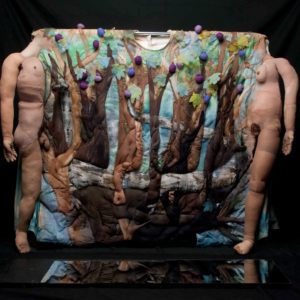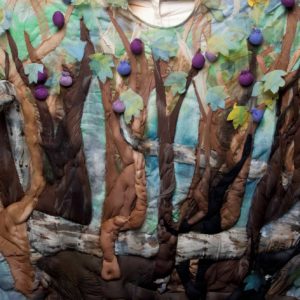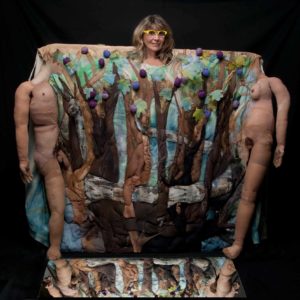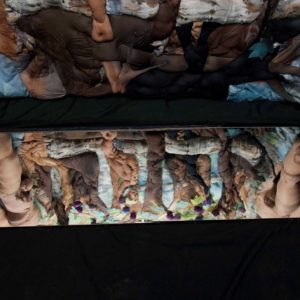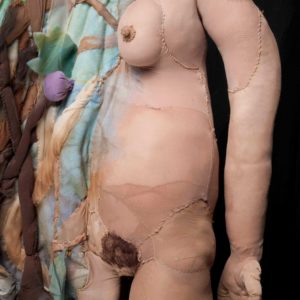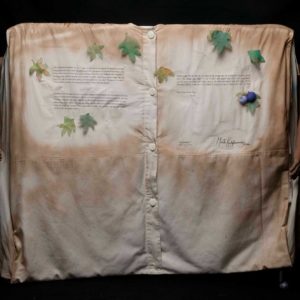By Tova Shvartzman
We have been shaped by ancient myths.
Ancient voices nesting in sacred texts.
Myths that today reveal traces of survival, reborn in fields lying beyond the mainstream.
Art is where what is newly invisible, becomes visible. Recovering productions built up over centuries on top of those texts, encourages new perspectives.
Post-modernity has built other myths. Among them, the certainty of full pleasure; the eternity of the ageless body; and a world in which the new God has a new name: Science.
Two kinds of knowledge, myths and science, offer different answers to the mysteries of what is real about the origin, what is real about sex, and what is real about death.
The Creation Story in Genesis of Eve, the first woman and mother, combines all three.
Written in Hebrew, in clear short phrases, creates that effect of language that is meaning and which demands interpretation. Summoned by exegetes and believers, feminists and misogynists, psychoanalysts and philosophers, writers and artists, Eve makes those who read believe that she is not mere words. The symbolically imagined Eve, touches what is real of the human condition.
Truth has the structure of fiction; a fiction that as the story develops has layered innumerable texts on the Text.
In it, Eve stands as protagonist and instrument.
In the scene of the Garden of Eden we witness a break with instinct, one that is always repeated, always the same. That break, in the fathomless time of Genesis, is the effect of the word and generator of desire...
The quartet of actors, God, the Serpent, Adam and Eve, move in comedic steps that foreshadow tragedy.
And as with all comedy, misunderstandings reign.
And through misunderstanding, desire slips in.
The ambiguity of the God that says “You shall not eat of the Tree of Knowledge of Good and Evil ... because if you do, you will die....” flourishes in Eve. Because he says nothing about that Other Tree, the Tree of Life, the one whose fruit gives you eternal life.
Further proof that the act of forbidding generates the object of desire...
The translation from Hebrew betrays the multiple meaning of ``Knowledge`` (daat). “To Know” means above all the sexual act between partners. Not any act; the act that is a union before the Law. The one that joins man and woman in ``one flesh`` and establishes a binding tie.
Other terms are used in Hebrew to refer to sexual intercourse in a purely carnal sense.
To know (and Adam knew Eve…) is also to conceive children.
Eve is the bearer, the apparent cause of Expulsion and Death. And she is also the real bearer of children, of Life, of History, all of which begin when the gates of the Garden of Eden close.
Myth traces what men have said about women for centuries: their danger, threat, and sublimity all at once.
No one is innocent in the Text...
Even God is unaware of the behavior of his Creation. The Serpent, which encourages them to take divine words literally, is also ignorant; as is Eve who listens to the Serpent; and Adam, who is able to say: ``She (Eve) incited me... ``
No one is innocent in their desire... As the Talmud says: ``You must assume responsibility even for your involuntary acts``.
Subjective responsibility implies choice.
Some midrashim (a particular kind of rabbinic literature), which analyze and interpret the text of Genesis, are surprising because of their audacity and the way they capture the vagaries of human desire.
The midrash in which Eve has intercourse with the Snake takes up versions of other myths, using some words from the original text to question the sexuality of women.
Several cultures, not just Judaism, see in the Serpent the ultimate carnal danger for women. Not the danger of dying, but of lying down with the snake and experiencing a mysterious pleasure.
An unknown Pleasure, attributed to women, that, paraphrasing the Talmud, men fear: ``Women enjoy themselves ten times more than men.``
Echoes of Tiresias, who every seven years mutates into a woman or a man, blind as a result of seeing two snakes copulating, and who is well aware of how both sexes experience pleasure...
Eve is then (once again) the one who provokes the beautiful Freudian question: ``Was will das Waib`` (What does a woman want?``)?
The work of Kupferminc (S - NAKED) penetrates into the territory of Eve´s ``unknown continent``.
Like the Zen archer's arrow, this work hits the mark, not as a result of the archer’s good eyesight, but because of the gaze from which it departs.
Making the invisible visible...
Without betraying the script on which the work is based, in S-NAKED everything seems to follow the literalness of the text.
Our gaze falls on the colorful profusion of the Garden of Eden and its actors.
And yet... something else...
The mirror that appears on another plane, on the floor, is the key ... It is not the mere reflection of what is seen on the vertical plane. It's another perspective.
An effect of anamorphosis, Cause appears:
The letters of the Name, the Tetragrammaton, unpronounceable but written, are formed from the Serpent. (Or is it the other way around?) And it invites us to re-read the myth.
S - NAKED undresses the text of Genesis ... and a veil falls from our eyes.
